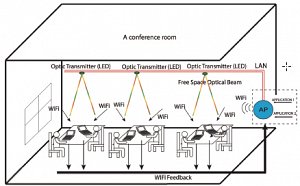LED Lights Increase WiFi Bandwidth by 10 Times: New Progresses for Technology and Innovation

At Oregon State University, researchers have developed a new technology capable of increasing the bandwidth of WiFi systems by 10 times, thanks to the use of LED lights for information transmission.
The new technology could represent an add-on to the widespread traditional WiFi systems, reducing bandwidth problems in crowded locations, such as libraries, coffee shops and airport terminals, as well in domestic context in homes where different people have several devices connected via WiFi. According to the experts, the progresses in LED technology allowed to modulate LED light more rapidly, introducing the opportunity of exploiting light for wireless transmission in a “free space” system of optical communication.
Thinh Nguyen, an OSU associate professor of electrical and computer engineering, said that: “In addition to improving the experience for users, the two big advantages of this system are that it uses inexpensive components, and it integrates with existing WiFi systems”. Nguyen collaborated with another assistant professor, Alan Wang, to build the first prototype.
The first prototype was called WiFO. It uses LEDs that are beyond the basic visual spectrum of humans, creating some kind of invisible one meter square one of light where the data is transmitted. To solve the problem of the limited area of information exchange, the researchers developed a hybrid system that can switch between different LED transmitters installed on a ceiling and the traditional WiFi system.
Nguyen expressed his thoughts saying: “I believe the WiFO system could be easily transformed into a marketable product, and we are currently looking for a company that is interested in further developing and licensing the technology”.
The new system can potentially transmit at up to 100 megabits per second. Even thogh some WiFi systems have similar capacities of bandwidth, it is important to notice that it has to be divided among the connected devices, with the result that users may receive just 5 to 10 megabits. The new hybrid system, instead, could deliver between 50 and 100 megabits to each user.
In homes where devices such as smartphones, computers, tablets and television may be connected to the same connection at the same time, the new system would solve classic issues as slowness of video streaming and buffer loading times.
The receivers of the new data are essentially small photodiodes that would cost less than a pound each and could be connected through a basic USB system or, eventually, be incorporated in the next generation of smartphones, tablets and laptops.
A paper about the technology was published in the 17th ACM International Conference on Modeling, Analysis and Simulation of Wireless and Mobile Systems. The National Science Foundation supported the new research.
Written by: Pietro Paolo Frigenti

06 Jul 2017 01:06:21
Thanks for contributing. It’s helped me understand the topic.